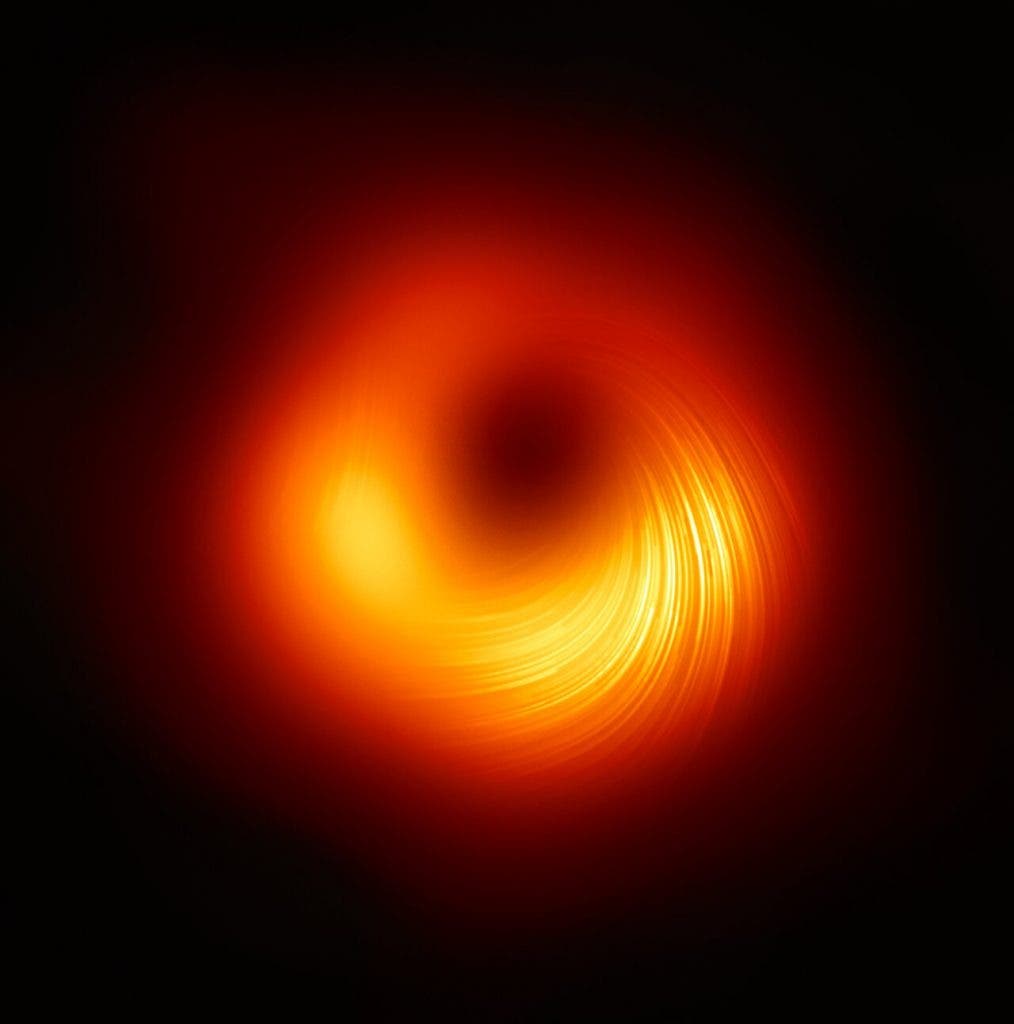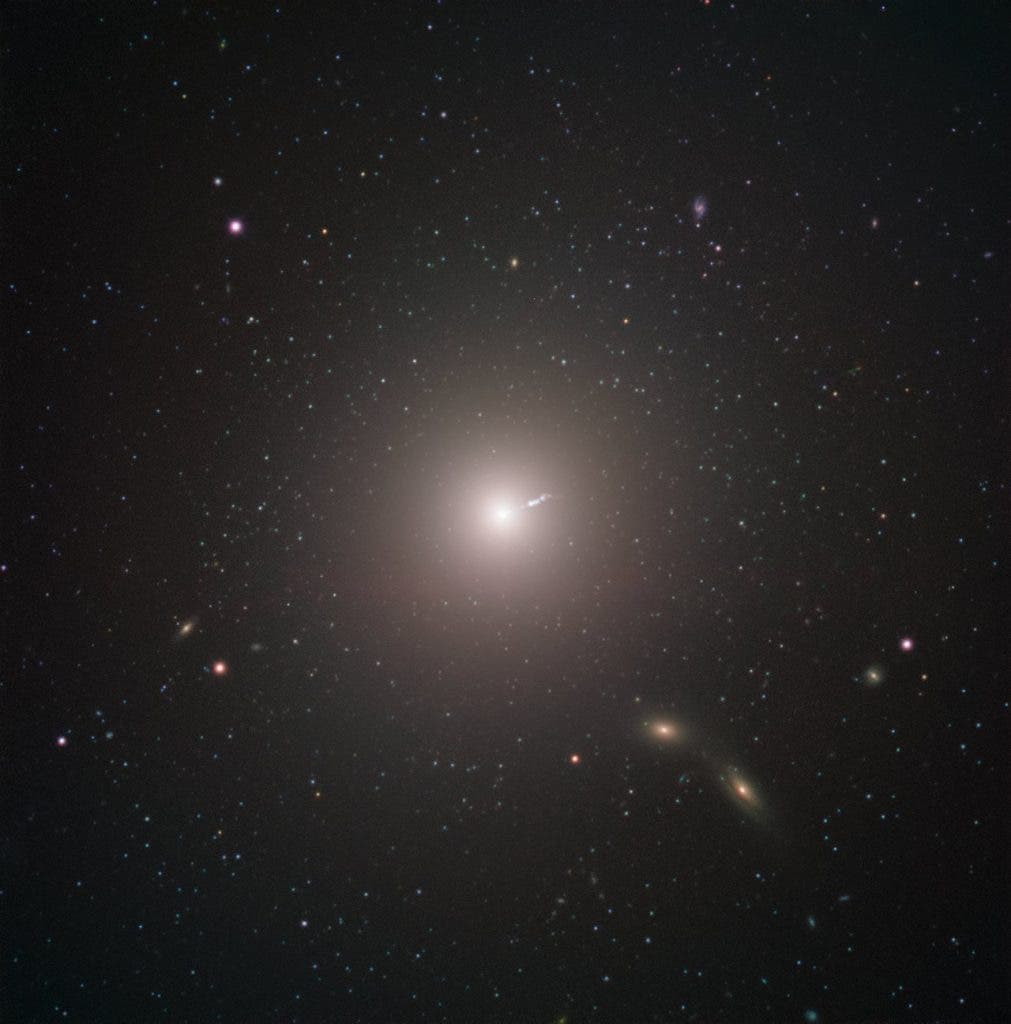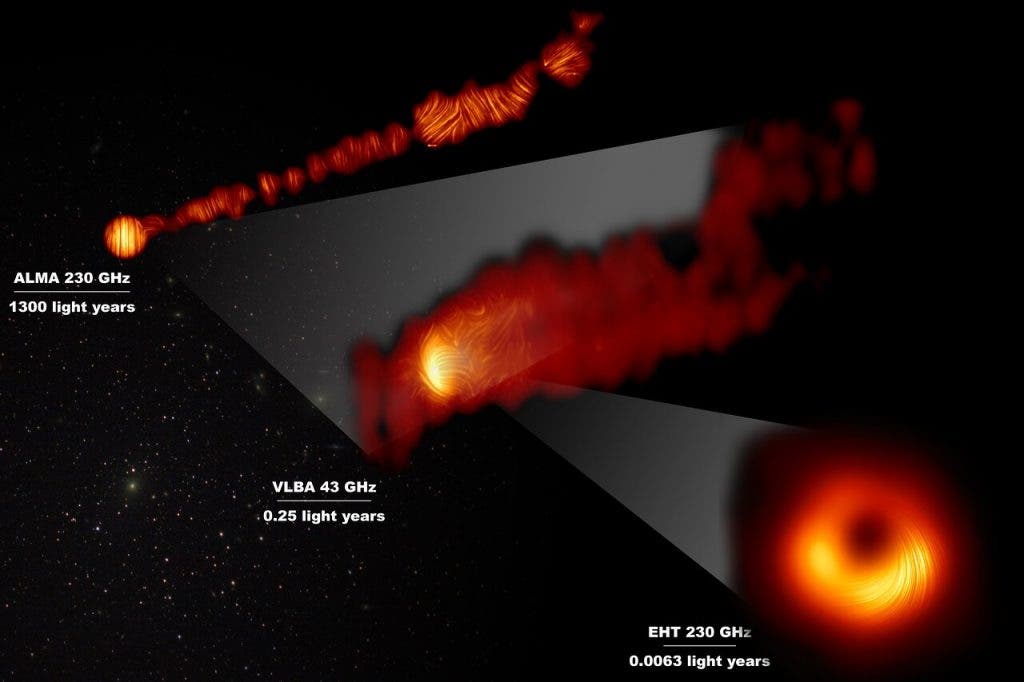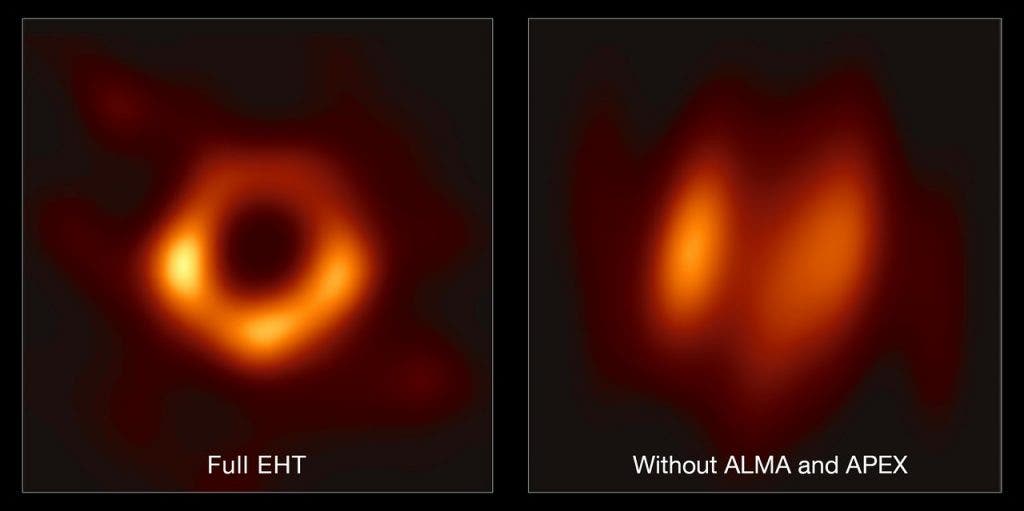Using the Event Horizon Telescope (EHT) to observe the supermassive black hole at the centre of the galaxy Messier 87 (M87), astronomers have once again produced another first in the field of astronomy and cosmology.
Following up on the image of M87’s black hole published two years ago–the first time a black hole was imaged directly–astronomers at the EHT collaboration have captured a stunning image of the same black hole, this time in polarized light.
The achievement marks more than just an impressively sharp and clear second image of this black hole however–it also represents that first-time researchers have been able to capture the polarization of light around such an object.
Not only does this reveal details of the magnetic field that surrounds the supermassive black hole, but it also could give cosmologists the key to explaining how energetic jets launch from the core of this distant galaxy.

“M87 is a truly special object! It is tied for the largest black hole in the sky with the black hole in our galaxy–Sagittarius A*, ” Geoffrey C. Bower, EHT Project Scientist and assistant research astronomer at the Academia Sinica Institute of Astronomy and Astrophysics, tells ZME Science. “It’s about one thousand times further away but also one thousand times more massive.
“The M87 black hole’s home is in the centre of the Virgo Cluster, the nearest massive cluster of galaxies, each with its own black hole. This makes it a great laboratory for studying the growth of galaxies and black holes.”
Geoffrey C. Bower, Academia Sinica Institute of Astronomy and Astrophysics.
Along with Monika Mościbrodzka, Coordinator of the EHT Polarimetry Working Group and Assistant Professor at Radboud University, Netherlands, Bower is one of the authors on two papers detailing the breakthrough published in the latest edition of The Astrophysical Journal Letters.

“We are now seeing the next crucial piece of evidence to understand how magnetic fields behave around black holes, and how activity in this very compact region of space can drive powerful jets that extend far beyond the galaxy,” says Mościbrodzka.
“We have never see magnetic fields directly so close to the event horizon,” the astronomer tells ZME Science.
“We now, for the first time, have information on how magnetic field lines are oriented close to the event horizon and how strong these magnetic fields are. All this information is new.”
Deeper Into the Heart of M87
The release of the first image of a black hole on the 10th of April 2019 marked a milestone event in science, and ever since then, the team behind that image has worked hard to delve deeper into M87’s black hole. This second image is the culmination of this quest. The observation of the polarized light allows us to better understand the information in that prior image and the physics of black holes.

“Light is an electromagnetic wave which has amplitude and direction of oscillation or polarization,” explains Mościbrodzka. “With the EHT we observed that light in the M87’s surrounding ring is polarized meaning that waves oscillation have a preferred direction.”
This polarization is a property of synchrotron radiation that is produced in the vicinity of this black hole. Polarization occurs when light passes through a filter–think of polarized sunglasses blocking out light and thus giving you a clearer view–thus the polarization of light in this picture accounts for this clearer view of M87’s black hole, which reveals a great deal of information about the black hole itself.
“The polarization of the synchrotron light tells us about the orientation of magnetic fields. So by measuring light polarization we can map out the magnetic fields around the black hole.”
Monika Mościbrodzka, Coordinator of the EHT Polarimetry Working Group and Assistant Professor, Radboud University
Capturing such an image of polarized light at a distance of 55 million light-years is no mean feat, and is only possible with the eight linked telescopes across the globe that comprise the EHT. Together these telescopes–including the 66 antennas of the Atacama Large Millimeter/submillimeter Array (ALMA)–form a virtual telescope that is as large as the Earth itself with a resolution equivalent to reading a business card on the Moon.

“As a virtual telescope that is effectively as large as our planet the EHT has a resolution power than no other telescope has,” says Mościbrodzka. “The EHT is observing the edge of what is known to humans, the edge of space and time. And for the second time, it has allowed us to bring to the public the images of this black hole.”
This image–as the above comparison shows– has had its clarity enhanced immensely by calibration with data provided by the Atacama Pathfinder EXperiment (APEX).
Of course, these magnetic fields are responsible for much more than just giving us a crystal clear image of the black hole they surround. They also govern many of the physical processes that make black holes such powerful and fascinating events–including one of M87’s most mysterious features.
How Magnetic Fields Help Black Holes ‘Feed’
The M87 galaxy–55 million light years from Earth– is notable for its powerful astrophysical jets that blast out of its core and extend for 5000 light-years. Researchers believe that these jets are caused when some of the matter at the edge of the black hole escapes consumption.
Whilst other matter falls to the surface of the central black hole and disappears to the central singularity, this escaping matter is launched into space as these remarkable jets.

Even though this is a more than plausible explanation, many questions still remain about the process, namely, how an area that is no bigger than our solar system creates jets that are greater in length than the entire galaxy that surrounds it.
This image of the polarized light around M87’s black hole which offers a glimpse into this inner region finally gives scientists a chance to answer these mysteries.
“Our planet’s magnetosphere prevents ionized particles emitted by the Sun from reaching the Earth’s surface. In the same way, strong black hole magnetic fields can prevent or slow down the accretion of matter onto the black hole,” Bowers says. “Those strong magnetic fields are also powerful for generating the jets of particles that flow at near the speed of light away from the black hole.”
By mitigating the feeding process of their central black holes, however, these magnetic fields may have an influence that like the jets they create may extend even further than M87 itself. They could be affecting the entire galactic cluster.
“Magnetic fields can play a very important role in how black holes ‘eat.’ If the fields are strong enough, they can prevent inflowing material from reaching the black hole. They are also important in funnelling matter out into the relativistic jets that burst from the black hole region. These jets are so powerful that they influence gas dynamics amongst the entire cluster of galaxies surrounding M87.”
Geoffrey C. Bower, Academia Sinica Institute of Astronomy and Astrophysics.
This means a better understanding of the magnetic fields around M87’s black hole also gives researchers an improved understanding of how the matter behaves at the edge of that black hole and perhaps of how such things affect neighbouring galaxies and their evolution.
And from the image of M87’s black hole the EHT team have developed, it looks clear that of the various models that cosmologists have developed to describe the interaction of matter at the edge of black holes, only those featuring strongly magnetized gases can account for its observed features.
“We have now a better idea about the physical process in the ring visible in the image,” Mościbrodzka says. “We now know more precisely how strong magnetic fields can be near a black hole. We also know more accurately at what rate the black hole is swallowing matter. And we have a better idea of what the black hole might look like in the future.”

In terms of what is next for black hole imaging, both Mościbrodzka and Bowers are clear; they have their sights set on a black hole that is closer to home than M87–the one that sits at the centre of the Milky Way, which despite being closer to home, could be a tougher nut to crack in terms of imaging.
“We’re hard at work on a problem that we know everyone wants to see; an image of the black hole at the centre of our galaxy,” says Bowers. “This is really tricky because the gas around the black hole moves so fast that the image may be changing on same the time scale that it takes to snap our picture. We think we know how to handle this problem but it requires a lot of technical innovation.”
Given the advancements already made by the EHT collaboration team, it would be unwise to bet against them achieving this lofty goal at some point in the not too distant future.
“We’ve gone from imagining what happens around black holes to actually imaging it!” Bowers concludes. “In the near future, we’ll be able to show a movie of material orbiting the black hole and getting ejected into a jet. I never thought I would see anything like this.
“Black holes are the simplest but most enigmatic objects in the Universe. These observations are just the beginning of the road to understanding them.”
Geoffrey C. Bower, Academia Sinica Institute of Astronomy and Astrophysics.


